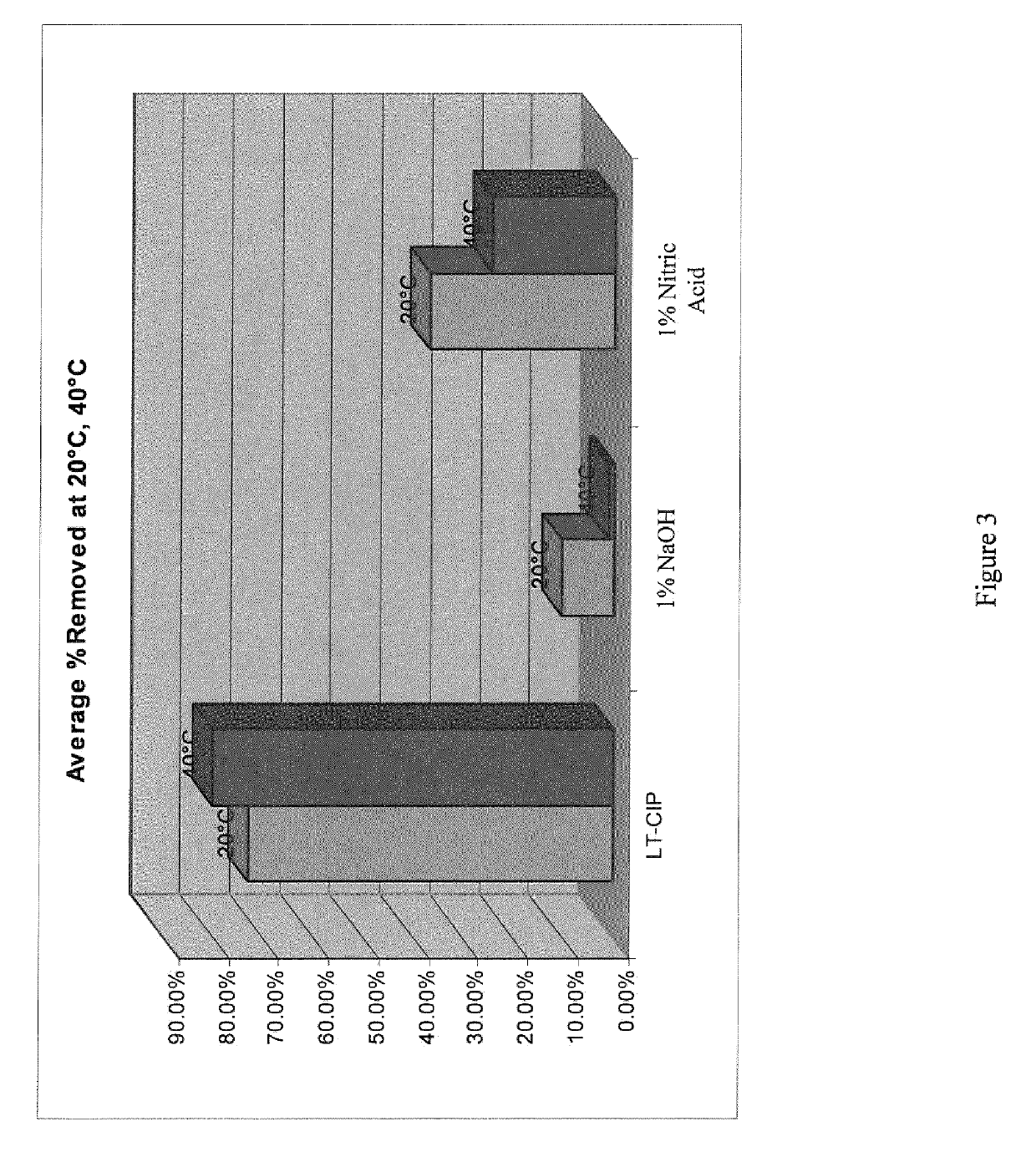Use of activator complexes to enhance lower temperature cleaning in alkaline peroxide cleaning systems
a technology of alkaline peroxide and activator complex, which is applied in the direction of detergent composition, detergent compounding agent, liquid cleaning, etc., can solve the problems of large energy and water consumption of conventional clean in place techniques, and affecting the effect of cleaning efficiency
- Summary
- Abstract
- Description
- Claims
- Application Information
AI Technical Summary
Benefits of technology
Problems solved by technology
Method used
Image
Examples
example 1
Dairy Soil Removal Test
[0151]This experiment was run to determine the ability of the methods of the present invention to remove dairy soils from stainless steel surfaces. For this test, 316 stainless steel coupons (5 cm×10 cm) were first cleaned and dried. 5 milliliters of condensed milk was applied to a rectangular area on the lower ⅔ of the coupons and allowed to dry for 24 hours. The soiled coupons were then used in two different tests: a beaker test, and a Cold Dairy Soil Test. The following solutions were prepared: (1) a 1% sodium hydroxide solution; (2) a mixture of 1% sodium hydroxide and 1% hydrogen peroxide; and (3) 1% hydrogen peroxide, and 100 ppm activator complex (Mn catalyst), followed by a 1% sodium hydroxide override solution after 2 minutes.
[0152]For the Beaker Test, 750 milliliters of test solutions 1 and 3 were prepared at 110F and placed on a stirring hot plate, with 350 rpm of stir bar agitation. The soiled coupons were placed into the beakers until one of the c...
example 2
Brewery Mash Soil Removal Test
[0156]This experiment was run to determine the ability of the methods of the present invention to remove brewery mash soils from stainless steel surfaces. The trays were soiled using the following technique. Whole dried barley was added to boiling water. The barley / water mixture was removed from the heat, stirred, and allowed to sit for at least 1 hour. The mixture was then refrigerated overnight. 750 grams of the mixture was then placed in a large capacity blender with 100 milliliters of water, and blended on low until a fairly homogenous slurry was formed. Then, 25 grams of the slurry was placed into a clean stainless steel tray and distributed evenly across the surface of the tray. The tray was then placed into an oven at 80-85° C. and baked for 3-5 hours.
[0157]The following test solutions were prepared: (1) 0.75 wt % sodium hydroxide, 0.4 wt % hydrogen peroxide, and 100 ppm manganese sulfate as an activator complex (the “LT-CIP” solution); (2) 1.0 w...
example 3
Low Temperature and Reduced Cleaning Chemistry Soil Removal Test
[0159]A test was run to determine the difference between a heat activated CIP cleaning method, and an exemplary low temperature, reduced cleaning chemistry CIP cleaning method of the present invention. Trays were soiled with brewery mash soil as described above in Example 2. Two different cleaning methods were compared.
[0160]In the first cleaning method (method A), a soiled tray was placed in a 1000 milliliter beaker with a pretreatment solution of 0.5 wt % hydrogen peroxide, and 100 ppm of an activator complex (manganese sulfate). After ten minutes, an alkaline override solution of 0.75 wt % sodium hydroxide was added to the beaker.
[0161]In the second cleaning method (method B), a soiled tray was placed in a 1000 milliliter beaker with a 1.0% solution of an acidic pretreatment that included 74% hydrogen peroxide (35%) as the active oxygen source, and had no activator complex. After ten minutes, an alkaline override sol...
PUM
| Property | Measurement | Unit |
|---|---|---|
| temperatures | aaaaa | aaaaa |
| temperature | aaaaa | aaaaa |
| temperature | aaaaa | aaaaa |
Abstract
Description
Claims
Application Information
 Login to View More
Login to View More - Generate Ideas
- Intellectual Property
- Life Sciences
- Materials
- Tech Scout
- Unparalleled Data Quality
- Higher Quality Content
- 60% Fewer Hallucinations
Browse by: Latest US Patents, China's latest patents, Technical Efficacy Thesaurus, Application Domain, Technology Topic, Popular Technical Reports.
© 2025 PatSnap. All rights reserved.Legal|Privacy policy|Modern Slavery Act Transparency Statement|Sitemap|About US| Contact US: help@patsnap.com



